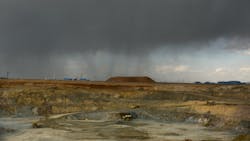SYDNEY — Anglo-Australian giant Rio Tinto reported a strong rise in iron ore production and shipments in the three months to September, drawing down on stockpiles as miners face weak commodity prices.
The world’s second-largest miner said iron ore production rose 12% for the quarter to 86.1 million tonnes compared to the same period last year. Shipments jumped 17% for the third quarter of 2015 to 91.3 million tonnes, as Rio completed infrastructure expansions at its Pilbara operations in Western Australia.
“Sales in the quarter exceeded production by 4.2 million tonnes, primarily drawing down on inventories at the mines,” Rio said in a statement. “This draw-down has been a key focus in 2015 and inventories built up during the infrastructure expansion phase are expected to be largely utilized by early 2016.”
The company said it expected 2015 shipments to remain unchanged at 340 million tonnes.
“The fact that Rio was able to significantly increase its iron ore shipping rate running down its inventory without leading to a significant increase in China’s inventory is encouraging,” CMC Markets’ chief analyst Ric Spooner said in a note. “It suggests that increased production from Australia is now being at least partly offset by production cuts from Chinese mines.”
Rio’s copper mine production fell 24% to 115,000 tonnes in the September quarter with full-year output forecast to reach about 510,000 tonnes compared to prior guidance of 500,000-535,000 tonnes.
The iron ore price has plunged by more than two-thirds since peaking in 2011 amid slowing growth in China — the world’s biggest commodity consumer — and a supply glut as leading exporters such as Rio, BHP Billiton and Fortescue boost production.
Official Chinese figures released Tuesday showed that imports tumbled by more than a fifth in September on the back of soft domestic demand.
Plummeting commodity prices have placed pressure on smaller producers with higher production costs.
Australian-listed Fortescue said last week that it had cut cash costs to $16.90 a wet metric tonne in the September quarter, a 24% fall from $22.16 in the previous three months.
Fortescue said efficiencies allowed it to buy back $384 million of debt, with the miner adding that costs were expected to drop further to $15 a wet metric tonne by July next year.
Copyright Agence France-Presse, 2015
About the Author
Agence France-Presse
Copyright Agence France-Presse, 2002-2025. AFP text, photos, graphics and logos shall not be reproduced, published, broadcast, rewritten for broadcast or publication or redistributed directly or indirectly in any medium. AFP shall not be held liable for any delays, inaccuracies, errors or omissions in any AFP content, or for any actions taken in consequence.
